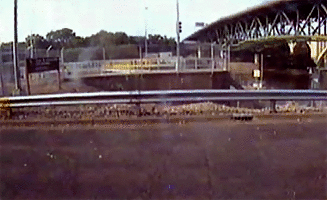Spanning Time
Motorists in rural Washington state crossing the Skagit River on Interstate 5 last Thursday didn't know it, but they were in for a hair-raising start to the Memorial Day travel weekend. As cars and trucks made their way over the steel-framed bridge, a loud pop was heard and the structure gave way, plunging several vehicles into the chilly waters below. Some injuries occurred and thankfully no deaths were reported.
The apparent cause?
A tractor-trailer with an over-sized load allegedly hit a piece of the bridge's overhead support framework, instantly weakening the structure. According to multiple reports, the stretch of road before the bridge did not list a maximum height limit for trucks, and the bridge could only handle a 14.5 foot tall load. Washington state officials approved a permit for an over-sized load of 15.9 feet. You can do the math. Details are forthcoming, but the National Transportation Safety Board chair Debbie Hersman says the incident is a "wake up call" for the country. I think the media caught the gist of it.
A wake-up call for what, exactly? That we shouldn't let loads that are too big travel over aging bridges? Okay, sure. Maximum clearance signs should be posted along interstate bridges and overpasses. Careful attention needs to be placed to the over-size load permit approval process. A few points could be made for better oversight. Gathering today's news, someone could easily get the impression that every US bridge is under an imminent threat of collapse. This whole scenario seems very familiar. Where have we heard about a bridge collapse that served as a "wake up call" for the country before? Oh, now I remember...
 |
| I-35 W Bridge Failure in Minneapolis, Minnesota, August 1, 2007 |
I think the larger, more beneficial discussion that the motoring public could have with transportation officials would be to discuss plans to replace antiquated bridges that are labeled "functionally obsolete" by federal officials, just as the I-5 bridge was. Its design and construction date to 1955, according to The Seattle Times. That's before the Federal-Aid Highway Act, folks. A person born in 1955 is eligible for an AARP membership and a senior cup of coffee at any McDonald's in the country. But this bridge born in 1955 is still expected to keep serving 70,000 cars and trucks a day.
The Minneapolis I-35W bridge started life during the Johnson administration. It was even known to have fractured and bowed support gussets months before its collapse in the summer of 2007. It had been labeled "structurally deficient" 17 years prior to its collapse and faced annual inspections and spot repairs as less-costly alternative to total replacement.
 |
| Inspection Photos of Bowed Gussets on the I-35W Bridge Over the Mississippi River 4 Years Before it Gave Way, Killing 13 and Injuring 145. |
Civil engineers are quick to point out that even if a structure is technically functionally obsolete or deficient, its not akin to saying its dangerous or needs to be replaced instantly. (One could argue that our '47 Chevrolet is functionally obsolete or deficient.) That's a good point, but a lot of these bridges could stand to be replaced in the coming years. If you really want a pick-me-up, read the Infrastructure Report Card for 2013 put out by the American Society of Civil Engineers. That will definitely make you feel all kinds of safe. The good news is Illinois received a D+ overall, which isn't technically failing. But it does make me say a little prayer now and then before I accelerate over a large body of water.
Was the I-5 collapse another "wake-up call" as the NTSB's Debbie Hersman put it? I dunno. Maybe. Simply stated, wake-up calls don't mean anything if you don't act on them . We've known as a nation that thousands of mid-century (and older) bridges, roads, water lines, power grids, and tunnels are crumbling beneath us. There's safety and security concerns a-plenty. Funding is a challenge, and make-shift fixes are clearly not going to cut it in the long term. The alarm continues to buzz away on our nightstand and we've been hitting the snooze button on infrastructure for about 30 years now. Maybe one day we'll wake up, take a shower, get a few cups of coffee in us and go to work.
-D





Comments
Post a Comment
Thank you for your feedback on Throwin' Wrenches.